Daisen Kofun
| Daisen Kofun | |
|---|---|
|
Native name Japanese: 大仙陵古墳 | |
 Aerial view of tomb | |
| Location | Sakai, Osaka |
| Coordinates | 34°33′50″N 135°29′13″E / 34.564°N 135.487°ECoordinates: 34°33′50″N 135°29′13″E / 34.564°N 135.487°E |
| Area | 460,000 m2 (110 acres) |
| Elevation | 20 m (66 ft) |
| Height | 35 m (115 ft) |
| Built | 5th century |
| Governing body | Imperial Household Agency |
| Website | www.city.sakai.lg.jp |
The Daisen Kofun is a burial mound in Sakai, Osaka Prefecture, Japan. The mound, or kofun, is considered to be the largest grave in the world by area. The Daisen Kofun is part of a larger complex of tombs known as the Mozu tombs spread across Sakai City.
History
The Daisen Kofun mound and tomb complex are believed to have been constructed over a period of 20 years in the mid 5th century during the Kofun Period. While it cannot be accurately confirmed, it is commonly accepted that the tomb was built for the late Emperor Nintoku.[1] The Imperial Household Agency of Japan treats it as such.
In 2010, the Japanese government proposed that Daisen Kofun, and the entire cluster of Mozu Tombs and Furuichi Tombs, be designated a UNESCO World Heritage Site.[2]
Description
The Daisen Kofun mound is approximately 500 metres (1,600 ft) long and 300 metres (980 ft) across at its widest point, while the entire tomb area is 840m long.[3] Enclosed by three moats, the mound rises approximately 35m above the surrounding terrain. The inner moat is the widest of the moats at approximately 60 metres (200 ft). The mound is approximately 100,000 square metres (1,100,000 sq ft) in area, and the entire tomb is 460,000 square metres (5,000,000 sq ft).
Today, the tomb is off-limits and protected by the Imperial Household Agency in the centre of Sakai City. The moats have been maintained and provide a sanctuary for fish and waterbirds. The mound itself is completely overgrown by vegetation. A viewing platform from the second (middle) moat is accessible at the south side of the site. The viewing platform is 500m away from Mozu Station on the Hanwa Line and is directly across the street from the Sakai City Museum.[4] This museum provides visitors with more information about the kofun and its history.
References
- ↑ "堺市・仁徳陵古墳". kiis.or.jp. Retrieved 23 February 2017.
- ↑ Centre, UNESCO World Heritage. "Mozu-Furuichi Kofungun, Ancient Tumulus Clusters - UNESCO World Heritage Centre". unesco.org. Retrieved 23 February 2017.
- ↑ city, Sakai. "仁徳天皇陵古墳(大山古墳) 堺市". sakai.lg.jp. Retrieved 23 February 2017.
- ↑ city, Sakai. "堺市博物館 堺市". sakai.lg.jp. Retrieved 23 February 2017.